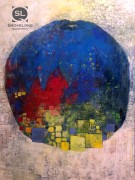I know writers hate this question, but where did the idea for this come from? Did it start with a sentence? A phrase? Or with something else? How do you tend to find your way into your pieces?
I was on a bus one morning about three weeks ago, heading to downtown San Francisco. I looked out the window and saw a house that was painted very bright orange—the “reflector vest” orange color of Two’s house in the story. That kicked up a memory of a woman in my moms’ group thirteen years ago, who had a bright orange house, and whose neighbors had taken her and her husband to task for painting their house a color that, the paranoid, snobby neighbors maintained, would compromise their own resale value (this is the kind of thing that might only happen in San Francisco—officious neighbors scolding you about the color of your house). So the germ of the story was that lurid color, and some effete, pragmatic person recoiling from it. I started writing the story immediately. I didn’t have my notebook on me, so I typed the story on my phone. It’s the first time I’ve ever written a story on my phone; that first draft had some hilarious autocorrects.
Tell me about your ultimate triangle. And who would be your nos. One and Two?
Wait, does this question mean what I think it means?! That is, am I allowed to cherry-pick from all the world who my One and Two would be? And are there any rules governing this choice? Does One need to be a sexy, entitled prick, and Two a nurturing slob? Or do they need to be rivals in some established real or fictional construct, like Heathcliff and Edgar Linton? I may be overthinking this question! I’m going to assume they have to be already established rivals or counterparts, and I’m going to go with Cecil Vyse and George Emerson from the film version of A Room with a View. Those two incarnate some One and Two traits recombined (Cecil is unpleasant and entitled, like One, but not really sexy—though Daniel Day-Lewis’s radiance beams through even Cecil’s nerd mask).
I Google-stalked you a little and saw that you teach flash. Who are some of the writers or pieces that you’re teaching? What advice would you give to someone just starting out; or to someone who’s been going at it for a while but needs or wants to try something new?
The semester just started, and the first thing we’re reading is The Best Small Fictions 2018, then Lydia Davis, Amy Hempel, Kathy Fish, Jayne Anne Phillips, Michael Czyzniejewski, Joy Williams, Amelia Gray, Michelle Ross, Sherrie Flick, Jason Sinclair Long, Rebecca Schiff … so many good stories and collections! As we all know, the best way to improve as a writer is to read great stories and to pick up some useful tricks. I don’t know what advice I have to dispense—I’m still figuring out flash myself— but in class today we were discussing a Kevin Moffett flash, “Sixth Wonder,” that has this glorious line about the narrator’s mother: “She and my sister fought over a dollhouse a few years ago, and now my sister calls her that woman and rarely visits her.” It’s such a wonderful bouillon cube of a sentence! My students spent a good ten minutes talking about what Moffett achieves by having this family rupture occur over, of all possible provocations, a dollhouse. With flash, you have to nail the details. They have to shout.
I love the way you write flawed characters; they feel so real to me. I’m not sure what the question here is; maybe it’s just a compliment. Wait. I know. How do you write flawed characters in a way where they’re real and interesting versus repugnant and reprehensible (and uninteresting)? Is there a secret. Please tell me. (I’m not very good at this.)
Thank you! I read an interview with Claire Messud several years ago, where Messud gets really irritated about a silly question the interviewer asks her—something about why the narrator in The Woman Upstairs isn’t likeable. Really, you must read the interview—Messud makes the point in a brilliant, pithy, acerbic way that I am mangling—but Messud’s retort is, essentially, “Who cares about likeable? I want my characters to be interesting!” Messud argues that demand for likability is made of women writers, not men, and of female characters. It’s like the narrative equivalent of telling women, “Smile!” I like thorny, complicated, warts-and-all characters who are unapologetic about their flaws. Those are the people I feel compelled to figure out.
The voice is so wonderful in your piece; it has the kind of magic where it convinces you that the characters are still out there, doing stuff. What do you feel they’re doing now, off-page? Is Jenny any wiser? Did she ditch that no? One? What about her Two? Did La-TISS-ia ever have that baby? What are your hopes for them all?
Jenny will ditch them both, but I suspect Jenny will run through many more trials-and-errors before she finds the right person. She’ll become increasingly clinical about relationships, almost utilitarian: What will this experience teach me? What skills or pleasures or relevant life knowledge will I garner here? She’ll get disillusioned and swear off sex. Then she’ll do something to exfoliate her calloused emotions: travel by herself, take a cooking class and learn how to make complicated soups. I have hopes for Jenny, but she needs to grow up. Two will be fine; Twos are rubber balls, too resilient to bruise. La-TISS-ia will have a little girl with some equally difficult name (maybe Agnes, but pronounced French style: On-yes) and fuss incessantly with her bangs. She’ll divorce One before On-yes is in pre-school, and she’ll keep all the good luggage.



 The SmokeLong Grand Micro Contest (The Mikey) is now an annual competition celebrating and compensating the best micro fiction and nonfiction online.
The SmokeLong Grand Micro Contest (The Mikey) is now an annual competition celebrating and compensating the best micro fiction and nonfiction online.